3105 Aluminum Plate Sheet
Temper: H14/h24 Competitive Prices
What is Aluminum Grade 3105?
Aluminum grade 3105 is an alloy commonly used in the 3000 series of aluminum alloys. It consists primarily of aluminum, with traces of other elements such as manganese (Mn) and magnesium (Mg).
3105 Aluminum is known for its excellent corrosion resistance, making it suitable for a variety of applications exposed to wet or corrosive environments. It is commonly used in the manufacture of sheet metal, such as roofing, gutters, and siding, as well as in the production of beverage cans and automotive parts.
3105 aluminum alloy is essentially a 98% aluminum alloy with a small amount of additives added to increase strength, making it stronger than alloys 1100 and 3003. It cannot be hardened by heat treatment and has good corrosion resistance, formability and weldability.
3105 aluminum plate is a typical deep drawing material with good rust resistance, good electrical conductivity, high plasticity in the annealed state, good semi-cold work hardening plasticity, low cold work hardening plasticity, good corrosion resistance, good weldability, and mechanical processing Poor sex.
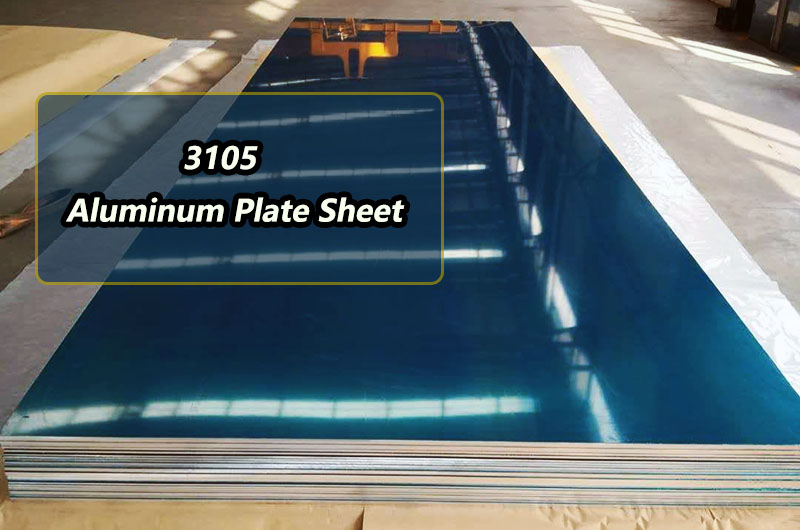
Adding manganese to the alloy increases its strength and machinability, making it easier to form and shape. The alloy is easy to weld and has good formability, making it easy to process through various manufacturing methods, including cutting, bending, and stamping.
3105 Aluminum Grade is a corrosion-resistant aluminum alloy widely used in sheet metal applications, especially in industries such as construction, automotive, and packaging.
The strength of 3105 aluminum plate is slightly higher than that of 3003 aluminum plate, and other properties are similar to 3003 aluminum alloy. 3105 aluminum plate has high plasticity in the annealed state. When semi-cold work hardening, the plasticity is still good. It has low plasticity, good corrosion resistance, good weldability, and poor cutting performance in the cold work hardening state.
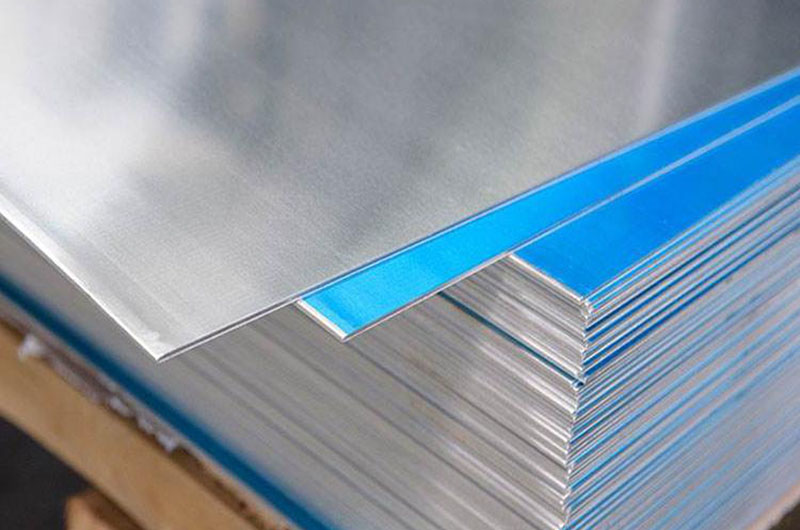
3105 aluminum alloy is an AL-Mn alloy series with all states such as O state, H12, H14, H18, H22, etc. 3105 aluminum plate is a good rust-proof aluminum, and also has good electrical conductivity. It has good mechanical properties, whether it is shear strength, tensile strength or yield strength. 3105 aluminum plate is the same as 3004 aluminum plate, with excellent arc welding performance, and can accept gas welding, contact spot welding and wire welding at the same time.
3105 aluminum plate can be used for room partitions, baffles, movable room panels, gutters and downspouts, sheet metal moldings, bottle caps and covers, fan blades, ceiling fans, etc. 3105 color-coated aluminum plate, 3105 bottle cap aluminum plate, 3105 engineering insulation aluminum plate, 3105 cake tray aluminum plate, etc.
Advantages of 3105 Aluminum Plate
- 1. Good electrical conductivity. Adding 0.3% copper element, the electrical conductivity can reach 41%;
- 2. Deep drawing performance. The deep drawing performance of 3105 aluminum alloy plate in O state is better than that of 3105 aluminum alloy plate in H26 state, and the deep drawing performance of 3105 aluminum alloy plate before low temperature treatment is better than that of 3105 aluminum alloy plate after 24h treatment.
- 3. 3105 aluminum plate has higher plasticity in annealing state, better plasticity in semi-cold hardening state, and lower plasticity in cold hardening state.
- 4. 3105 aluminum plate has excellent weldability and is suitable for all existing welding technologies, among which arc welding is the best method.
- 5. Other characteristics. Good corrosion resistance, good anodizing performance, poor machinability, etc.
Common Trade Names
UNS A93105, ISO AlMn0.5Mg0.5, Aluminium 3105, AA3105, Al3105
3105 Aluminum Plate Specifications
- Common Temper: H14, H16, H18, H24 (other states are also available upon request).
- Width: Typically between 1000 mm and 2000 mm (39.37 inches and 78.74 inches).
- Length: Usually between 2000 mm and 6000 mm (78.74 inches and 236.22 inches). Custom lengths are also available.
- Thickness: Common thicknesses range from 0.2 mm to 6 mm (0.0079 inches to 0.2362 inches). Thicker gauges are available upon request.
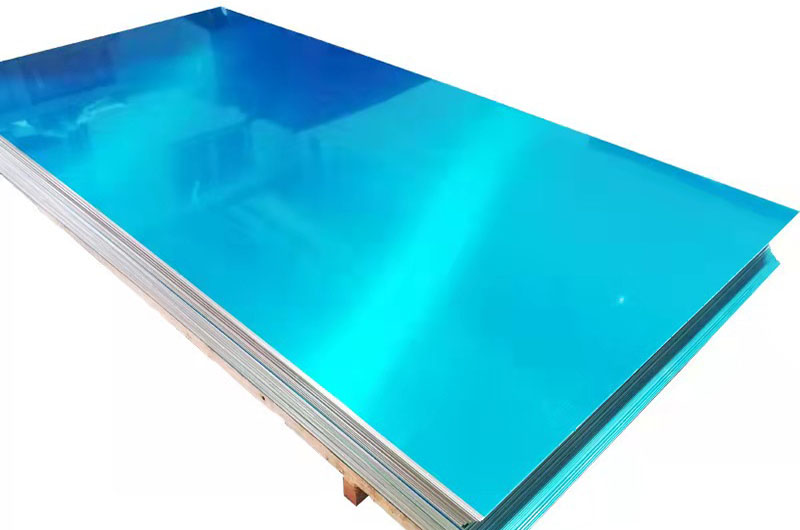
3105 Aluminum Plate Production Standards
3105 aluminum sheet can be produced according to various standards, including but not limited to:
- ASTM B209: Standard Specification for Aluminum and Aluminum Alloy Sheet and Plate.
- EN 485: Aluminum and aluminum alloys - Plate, strip, and plate.
3105 Aluminum Plate Product Certifications
Aluminum sheets can be manufactured to meet various certifications such as ISO 9001 (Quality Management System) and ISO 14001 (Environmental Management System). Specific certification depends on manufacturer and customer requirements.
3105 Aluminum Plate Performance Advantages
- A. It has certain corrosion resistance and strong stress corrosion cracking ability.
- B. It has strong plasticity, can be processed both hot and cold, and has certain brazing properties.
- C. The Cu content as an impurity element is controlled below 0.2%, which not only improves the tensile strength of the alloy, but does not affect the corrosion resistance of the alloy.
- D. Good electrical conductivity. With 0.3% copper added, the electrical conductivity can reach 41%.
- E. The 3105 aluminum plate has high plasticity in the annealed state, good plasticity in semi-cold work hardening, and low plasticity in cold work hardening.
- F. The excellent weldability of 3105 aluminum plate is suitable for all existing welding technologies, among which arc welding is the best method.
- G. Good anodizing performance, poor machinability, etc.
- H. It has average machinability, and the machinability can be improved in the harder state than in the annealed condition.
- I. 3105 aluminum plates should not be heat treated except for annealing during cold working. Even in the harder cold working state, the cold working properties are very good.
3105 Aluminum Plate Chemical Composition
| Element | 3105 |
| Silicon | 0.6 |
| Iron | 0.7 |
| Copper | 0.30 |
| Manganese | 0.30-0.8 |
| Magnesium | 0.20-0.8 |
| Chromium | 0.20 |
| Zinc | 0.40 |
| Titanium | 0.10 |
| Aluminum | balance |
| Other Elements (each) | 0.05 |
| Other Elements (total) | 0.15 |
3105 Aluminum Plate Mechanical Properties
Mechanical property requirements for the strain-hardened H12 temper (1/4 hard) specified in ASTM B209 and ASME SB209.
| Thickness (inch) | Yield Strength Min. (ksi) | Tensile Strength (ksi) | Elongation (%) Min. | |
| Min. | Max. | |||
| 0.017 – 0.019 | 15.0 | 19.0 | 26.0 | 1 |
| 0.020 – 0.031 | 15.0 | 19.0 | 26.0 | 1 |
| 0.032 – 0.050 | 15.0 | 19.0 | 26.0 | 2 |
| 0.051 – 0.080 | 15.0 | 19.0 | 26.0 | 3 |
Mechanical property requirements for strain hardened H14 temper (½ hard) as specified in ASTM B209 and ASME SB209
| Thickness (inch) | Yield Strength Min. (ksi) | Tensile Strength (ksi) | Elongation (%) Min. | |
| Min. | Max. | |||
| 0.017 – 0.019 | 18.0 | 22.0 | 29.0 | 1 |
| 0.020 – 0.031 | 18.0 | 22.0 | 29.0 | 1 |
| 0.032 – 0.050 | 18.0 | 22.0 | 29.0 | 2 |
| 0.051 – 0.080 | 18.0 | 22.0 | 29.0 | 2 |
Physical Properties for Alloy 3105
| Property | 3105 Data |
| Density, lb/in3 | 0.0983 |
| Modulus of Elasticity, psi | 10.0 x 106 |
| Coefficient of Thermal Expansion, 68-212˚F, /˚F | 12.1 x 10-6 |
| Thermal Conductivity, Btu/ft hr ˚F | 99 |
| Specific Heat, Btu/lb ˚F | 0.214 |
| Electrical Resistivity, Microohm-in | 1.504 |
3105 Aluminum Sheet Mechenical Property
| Alloy/Temper | Thickness | Tensile strength | Yield strength | Elongation % |
| mm | Mpa | Mpa | ||
| 3105 O/H111 | >0.2-0.5 | 100-155 | 40 | 14 |
| >0.5-1.5 | 15 | |||
| >1.5-3 | 17 | |||
| 3105-H12 | >0.2-0.5 | 130-180 | 105 | 3 |
| >0.5-1.5 | 4 | |||
| >1.5-3 | 4 | |||
| 3105-H22 | >0.2-0.5 | 130-180 | 105 | 6 |
| >0.5-1.5 | 6 | |||
| >1.5-3 | 7 | |||
| 3105-H14 | >0.2-0.5 | 150-200 | 130 | 2 |
| >0.5-1.5 | 2 | |||
| >1.5-3 | 2 | |||
| 3105-H24 | >0.2-0.5 | 150-200 | 120 | 4 |
| >0.5-1.5 | 4 | |||
| >1.5-3 | 5 | |||
| 3105-H16 | >0.2-0.5 | 175-225 | 160 | 1 |
| >0.5-1.5 | 2 | |||
| >1.5-3 | 2 | |||
| 3105-H26 | >0.2-0.5 | 175-225 | 150 | 2 |
| >0.5-1.5 | 3 | |||
| >1.5-3 | 3 | |||
| 3105-H18 | >0.2-3.0 | 195 | 180 | 1 |
| 3105-H28 | >0.2-1.5 | 195 | 170 | 2 |
| 3105-H19 | >0.2-1.5 | 215 | 190 | 1 |
Mechanical Properties with Different Temper
Requirements for strain hardened H14 temper (½ hard)
as specified in ASTM B209 and ASME SB209
| Material | Temper | Tensile Strength (N/mm²) | Yield Strength (N/mm²) | Elongation on 50mm | |||
| 0.5 mm | 0.8mm | 1.3mm | 2.6mm | ||||
| 3105 Aluminum Sheet | 0 | 110-155 | – | 16 | 18 | 20 | 20 |
| 3105 Aluminum Sheet | H12 | 130-175 | 115 | 2 | 3 | 4 | 5 |
| 3105 Aluminum Sheet | H14 | 160-205 | 145 | 2 | 2 | 3 | 4 |
| 3105 Aluminum Sheet | H16 | 185-230 | 170 | 1 | 1 | 2 | 3 |
| 3105 Aluminum Sheet | H18 | 215 min | 190 | 1 | 1 | 1 | 2 |
3105 Aluminum Plate Features
Machinability
Machinability of AL 3105 is fair. Oil lubricants should be used for all machining operations. Machinability of the alloy when in the harder (H) tempers is improved over machining in the annealed (O) condition.
Forming
The forming characteristics of the alloy are very good by all conventional processes regardless of temper. Bend radii should be in the one thickness to 2 t range for annealed, H12, H14 and H16 tempers. The H18 temper requires bend radii of 2 to 7 t, depending upon thickness of the material.
Welding
Weldability of this alloy is excellent by all commercial techniques. Arc welding is preferred for the best results.
Heat Treatment
This alloy does not respond to heat treatment except for annealing during cold working.
Forging
Forging, if required, may be done in the range of 950 to 700 F.
Hot Working
Hot working may be accomplished at 700 to 400 F.
Cold Working
The cold working characteristics of AL 3105 are very good, even in the harder cold worked tempers. Bend radii for sheet up to 1/16" thick vary from 1/2 to one t for all tempers.
Annealing
Annealing from a cold worked condition may be accomplished at 650 F followed by air cooling.
Aging
Not applicable to this alloy.
Tempering
Not applicable.
Hardening
Hardens to the H12, 14, 16, 18 or 25 tempers only by cold working.
3105 Aluminum Plate Surface Treatment
-
3105-h14 White Painted Aluminum Sheet
Common applications for 3105-H14 white painted aluminum include sign blanks, trailer sides and wall panels. It is lightweight, semi-smooth and finished in white paint.
-
3105 Anodized Aluminum Sheet
3105 anodized aluminum sheet is anodized to form an oxide layer, which improves its surface hardness and wear resistance. Anodized aluminum sheets are usually used in electronic equipment casings, decorative parts and other occasions where surface protection and aesthetics are required.
-
3105 Embossed Aluminum Sheet
The surface of embossed aluminum plate presents different patterns, textures or patterns. This not only increases the aesthetics of the aluminum plate, but also increases the anti-slip properties of its surface, so it is often used in stair treads, floors and other places where anti-slip functions are required.
-
3105 Color-coated Aluminum Sheet
3105 aluminum plates are coated and available in different colors and coating types to meet different decoration and protection needs.
-
3105 Perforated Aluminum Plate
3105 punched aluminum plate is a product made of 3105 aluminum alloy plate through punching process. Punching is a processing method that uses a die to punch out a specific hole shape from a metal sheet.
-
3105 Brushed Aluminum Plate
3105 aluminum plate is an aluminum alloy plate made by wire drawing. Brushing is a processing method that uses mechanical means to form uniform textures and patterns on the metal surface, thereby giving the metal surface a unique appearance and texture.
| Description | Type |
| 3105 embossed aluminum sheet | Diamond aluminum sheet of 3105 |
| 1 bar 3105 aluminum sheet | |
| 3 bar 3105 aluminum sheet | |
| 5 bar 3105 aluminum sheet plate | |
| 3105 color-coated aluminum sheet | Black 3105 color-coated aluminum sheet |
| White 3105 color-coated aluminum sheet | |
| Orange 3105 color-coated aluminum sheet | |
| Champagne 3105 color-coated aluminum sheet | |
| Charcoal 3105 color-coated aluminum sheet | |
| Red 3105 color-coated aluminum sheet | |
| Silver 3105 color-coated aluminum sheet | |
| Brandywine 3105 color-coated aluminum sheet | |
| Emerald Green 3105 color-coated aluminum sheet | |
| Indigo Blue 3105 color-coated aluminum sheet | |
| Pewter 3105 color-coated aluminum sheet | |
| Penske Yellow 3105 color-coated aluminum sheet | |
| Burgundy 3105 color-coated aluminum sheet | |
| Brite One Side 3105 color-coated aluminum sheet |
Common Dimensions of 3105 Aluminum Plate
- 4 x 8 3105 aluminum sheet plate
- 4 x 10 3105 aluminum sheet
- 5 x 10 3105 aluminum sheet
- 1000 x 1500mm 3105 aluminum sheet
- 1500 x 2000mm 3105 aluminum sheet
- 1500 x 3000mm 3105 aluminum sheet
- 2000 x 3000mm 3105 aluminum sheet
Typical 3105 Aluminum Plate
3105 H19 Aluminum Plate
H19 indicates the strain-hardened (cold-worked) temper of the aluminum alloy.
H19 tempering is achieved by causing the alloy to be significantly cold and deformed, resulting in increased strength and hardness. This temper provides higher mechanical properties compared to softer tempered conditions.
3105 H19 Aluminum is typically used in applications where strength and stiffness are critical. It is suitable for applications requiring resistance to deformation, such as structural components, automotive body panels, and load-bearing structures.
The increased strength of 3105 H19 makes it the first choice for applications where aluminum sheets or panels need to withstand heavy loads or high stress.
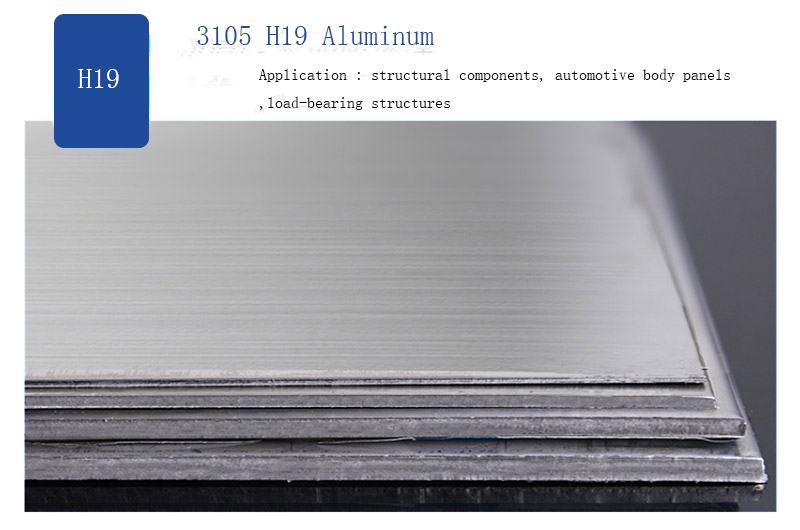
3105 H14 Aluminum Plate
"H14" represents the temper mark of aluminum alloy 3105.
H14 refers to the strain hardened (cold worked) and partially annealed temper.
In the H14 state, aluminum is relatively soft and moderately strong.
3105 H14 Aluminum is typically used in applications requiring good formability such as roofing, gutters, siding, and general sheet metal fabrication.
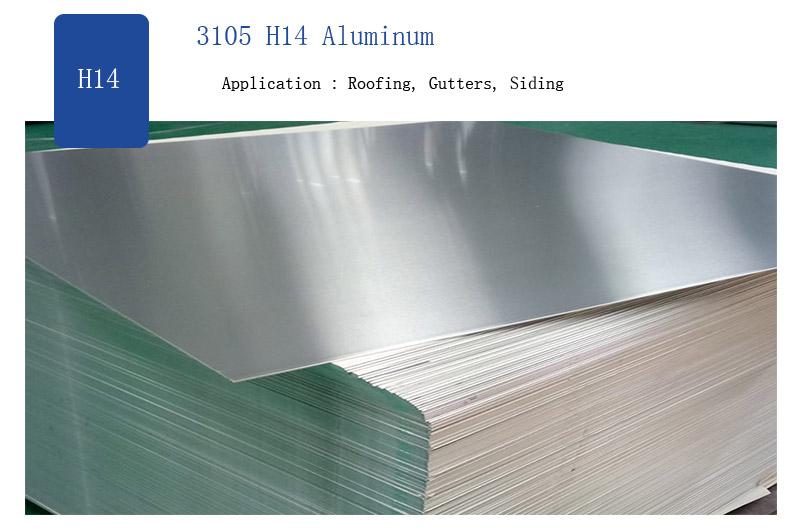
3105 H24 Aluminum Plate
"H24" is another temper name for aluminum alloy 3105.
H24 indicates the strain hardened (cold worked) and fully annealed condition.
In the H24 temper, aluminum has higher strength compared to H14 due to additional cold working and annealing.
3105 H24 Aluminum is commonly used in applications requiring increased strength and rigidity, such as certain structural components, automotive panels, and heat exchangers.
What is the 3105 Aluminum Plate used for?
3105 is typically used in applications that require greater strength than 1100 aluminum such as: residential siding, signage and mobile homes, room dividers, backsplashes, painted aluminum baseboards, blinds, light base materials. 3105 aluminum coils are commonly used in bottle caps, beverage bottle caps, cosmetic caps, etc.
Sheet Metal
3105 aluminum is often used to produce sheet metal for a variety of applications, and its corrosion resistance and formability make it suitable for outdoor applications exposed to a variety of elements.
- Temper: A common temperature for 3105 aluminum in sheet metal applications is H14, which indicates that the material has been strain-hardened and partially annealed. This state provides a balance between strength and formability.
- Application: It is commonly used for roofing, gutters, siding, and general construction purposes.
3105 Aluminum Roofing Sheet
Due to its high strength-to-weight ratio, 3105 aluminum panels reduce the weight of the roof while meeting the strength requirements of shingles. Not only that, the strong corrosion resistance of 3105 aluminum panels also improves the service life of aluminum roof panels.
3105 Aluminum for Beverage Cans
The beverage industry makes extensive use of 3105 aluminum for beverage cans due to its corrosion resistance, light weight and ability to be formed into complex shapes.
- Temper: The temper of 3105 aluminum used in beverage cans is usually H19, indicating a high-strength strain-hardening state.
- Application: soft drink industry, juice, beer, and other beverage cans, beverage industry.
Alloys used with 3105 for beverage cans are commonly referred to as the 3xxx series alloys, which include other aluminum-manganese alloys such as 3004 and 3005.
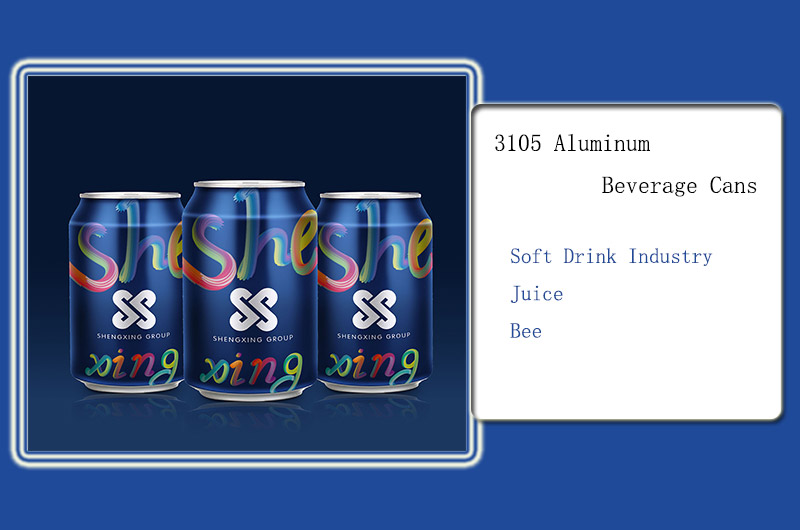
3105 Diamond Aluminum Sheet
Diamond aluminum plate is an aluminum plate with a raised diamond pattern on its surface. This pattern provides a textured and non-slip surface, making Diamond Aluminum Sheet suitable for applications in flooring, decking, toolboxes and storage cabinets, trailers and loading ramps.
Heat Exchangers
3105 aluminum is also used in the production of heat exchangers. Its excellent thermal conductivity enables efficient heat transfer, making it suitable for applications such as radiators, HVAC systems, and automotive cooling systems.
- Temper: Common tempers used in heat exchangers include H14, H16, or H24, which offer a balance of strength, formability, and corrosion resistance.
- Application: 3105 aluminum is used in heat exchanger components, radiators, and HVAC systems.
The alloys used with 3105 in heat exchangers may vary, but other aluminum-manganese alloys such as 3003 and 3004 are often used.
- Alloy: 3003, 3004
- Parts: heat exchanger assemblies, radiators, HVAC systems.
- Applications: Heating, ventilation, and air conditioning (HVAC) industry, automotive cooling systems.
3105 Automotive Aluminum Plate
Due to its formability and corrosion resistance, 3105 aluminum is used in various components in the automotive industry.
- Temper: Common tempers include H14, H16, or H18, depending on the desired balance of strength and formability.
- Application: It can be found in components such as body panels, trim, wheel wells, and heat shields.
The alloys used with 3105 in automotive parts can vary by application, but alloys such as 3003 and 5052 are commonly used with 3105.
- 3105 Aluminum: Used for body panels, trim, and heat shields in automotive applications.
- Alloys 3003 and 3004: Also used in automotive components such as body panels.
- Alloy 5052: Used in automotive body panels, structural components, and wheel housings.
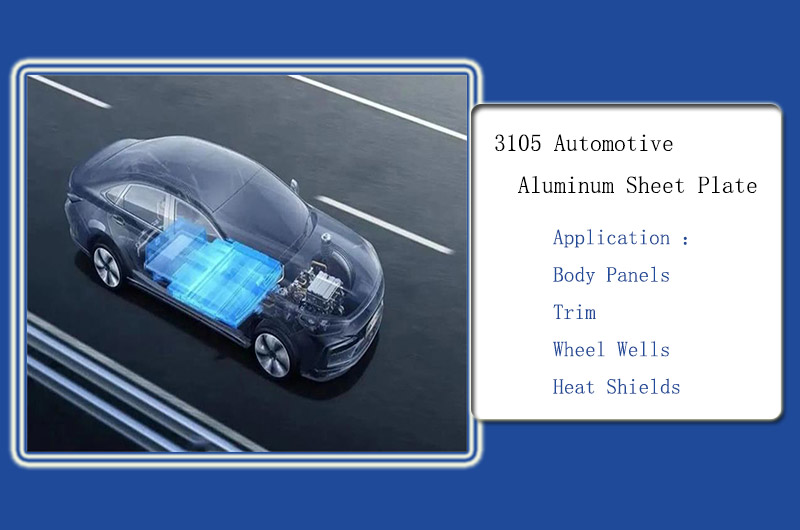
3105 Aluminum for Packaging
The versatility of 3105 aluminum makes it suitable for packaging applications. It can be made into containers, closures, and lids for food and beverage packaging as well as pharmaceutical packaging.
The tempering of 3105 aluminum for packaging applications can vary depending on specific packaging requirements.
- Temper: Usually tempered such as H14 or H16 to provide a balance of strength and formability. As an alloys, 3105 is often used as a standalone alloy for packaging purposes.
- Application: food and beverage packaging, pharmaceutical packaging
3105 aluminum: used for packaging containers and lids in the food and beverage industry, and pharmaceutical packaging.
Alloys 3003 and 3004: Also used in packaging applications for containers and lids.
General Fabrication
The ease of fabrication and machinability of 3105 aluminum makes it a popular choice for general fabrication purposes. It can be cut, bent, punched, and welded, making it suitable for a range of custom metal fabrication projects.
- Temper: Tempers such as H14, H16, or H18 are typically used to achieve the desired balance of strength and formability.
- Applications: Metal Fabrication Projects, Custom Fabrication
In general manufacturing, 3105 is often used as a standalone alloy.
- 3105 Aluminum: Used for a variety of general fabrication projects requiring custom components.
- Alloys 3003, 3004, and 5052: Also used for general fabrication of custom components.
These are just a few examples of the many applications for 3105 aluminum. Its corrosion resistance, formability, and light weight make it widely used in various industries.
What is the Difference between 3003 H14 and 3105 H24?
There are some differences between 3003 H14 and 3105 H24.
- Brinell hardness: 3003 H14 has 42 BHN, 3105 H24 has 47 BHN.
- Fatigue strength: 3003 H14 has only 60 MPa, while 3105 H24 has 74 MPa.
- Alloy composition: 3003 H14 contains more magnesium than 3105 H24. But 3105 H24 contains a bit of titanium, chromium and copper that 3003 H14 does not.
3003 Aluminum vs. 3105 Aluminum vs. 5052 Aluminum
Composition
- 3003 Aluminum: It is an aluminum-manganese alloy with a composition of approximately 98.6% aluminum and 1.2% manganese.
- 3105 Aluminum: It is an aluminum-manganese alloy with a slightly higher manganese content than 3003, usually around 0.3%.
- 5052 Aluminum: It is an aluminum-magnesium alloy that is approximately 97.2% aluminum and 2.5% magnesium.
Properties
Corrosion Resistance
- 3003 Aluminum: Provides good corrosion resistance, especially in indoor and non-industrial environments.
- 3105 Aluminum: Provides excellent corrosion resistance making it suitable for outdoor applications and exposure to moisture.
- 5052 Aluminum: Provides excellent corrosion resistance, especially in marine and saltwater environments.
Formability and Workability
- 3003 Aluminum: It has excellent formability and is easy to bend, stamp and weld. It is highly malleable and can be made into various shapes.
- 3105 Aluminum: Similar to 3003, it has good formability and processability, and is easy to manufacture and form.
- 5052 Aluminum: Provides good formability and machinability. It can be easily shaped and formed into complex parts.
Strength
- 3003 aluminum: moderate strength, suitable for general purposes that do not require high strength.
- 3105 Aluminum: Slightly stronger than 3003 due to the higher manganese content.
- 5052 Aluminum: Higher strength than 3003 and 3105 for applications requiring higher strength.
Applications
- 3003 Aluminum: Commonly used in general manufacturing, cookers, heat exchangers, chemical equipment, and roofing.
- 3105 Aluminum: Commonly used in sheet metal applications such as roofing, gutters, siding, beverage cans and general fabrication.
- 5052 Aluminum: Widely used in marine applications requiring higher strength and corrosion resistance, transportation panels, structural components, automotive components and general manufacturing.
It is important to note that the specific application and requirements will determine which aluminum alloy is the most suitable choice. Differences in composition and properties allow for different uses in different industries and applications.
3105 Aluminum Frequently Asked Questions
| Question | Answer |
| What is the difference between 3003 H14 vs 3105 H24? |
The difference between 3003 H14 and 3105 H24 lies in their aluminum alloy chemical composition and heat treatment states, resulting in slight variations in their physical and mechanical properties. |
| What are the specifications of 3105 H24 aluminum? | 3105 H24 aluminum has a yield strength of 152 MPa and an ultimate tensile strength of 179 MPa. |
| What are the specifications of 3105 H14 aluminum? | 3105 H14 aluminum has a yield strength of 152 MPa and a tensile strength of 172 MPa. |
| What is 3105 painted aluminum sheet? | 3105 painted aluminum is typically used for making signs, mobile homes, residential facades, and sheet metal processing. |
People also searched for Aluminum Plate
-
3104 Aluminum Plate Sheet
The performance of the 3104 aluminum plate is stable, the surface is smooth, smooth, and free of defects, and the tolerance is strictly controlled to meet the standard.
-
3004 Aluminum Plate Sheet
3004 aluminum is similar to 3003 aluminum, but it is stronger than 3003 alloy. 3004 aluminum also has good formability, good processability, excellent corrosion resistance and drawing characteristics.
-
3003 Aluminum Plate Sheet
3003 aluminum has excellent processability, weldability, and corrosion resistance. Compared with 1100 aluminum, 3003 aluminum is approximately 20% stronger.

